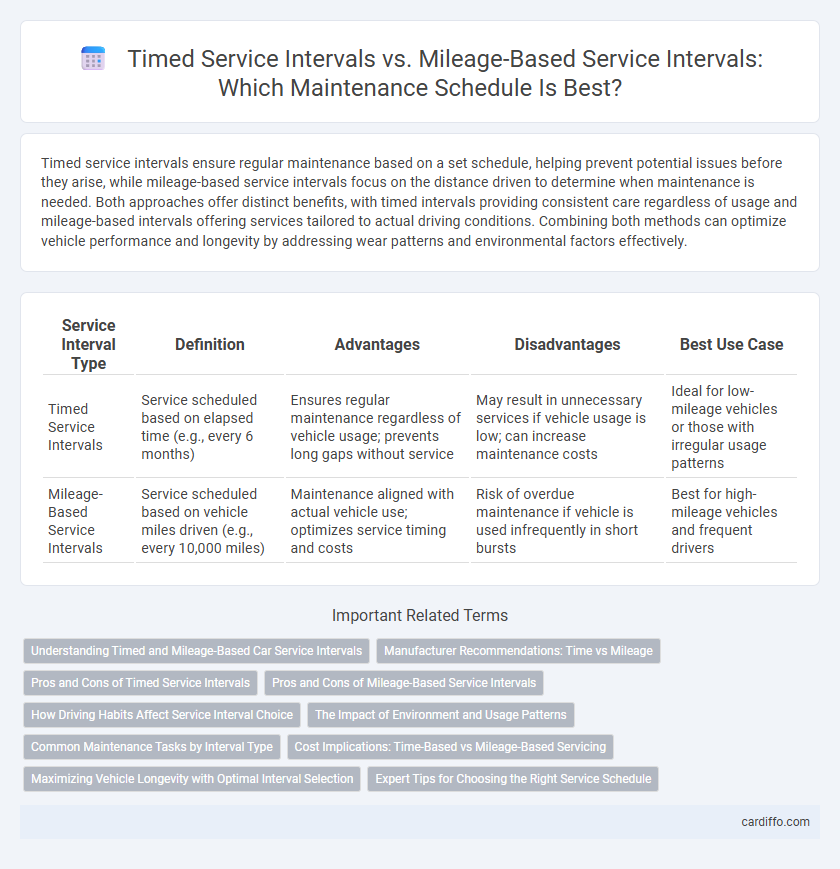Timed service intervals ensure regular maintenance based on a set schedule, helping prevent potential issues before they arise, while mileage-based service intervals focus on the distance driven to determine when maintenance is needed. Both approaches offer distinct benefits, with timed intervals providing consistent care regardless of usage and mileage-based intervals offering services tailored to actual driving conditions. Combining both methods can optimize vehicle performance and longevity by addressing wear patterns and environmental factors effectively.
Table of Comparison
| Service Interval Type | Definition | Advantages | Disadvantages | Best Use Case |
|---|---|---|---|---|
| Timed Service Intervals | Service scheduled based on elapsed time (e.g., every 6 months) | Ensures regular maintenance regardless of vehicle usage; prevents long gaps without service | May result in unnecessary services if vehicle usage is low; can increase maintenance costs | Ideal for low-mileage vehicles or those with irregular usage patterns |
| Mileage-Based Service Intervals | Service scheduled based on vehicle miles driven (e.g., every 10,000 miles) | Maintenance aligned with actual vehicle use; optimizes service timing and costs | Risk of overdue maintenance if vehicle is used infrequently in short bursts | Best for high-mileage vehicles and frequent drivers |
Understanding Timed and Mileage-Based Car Service Intervals
Timed service intervals are scheduled based on a set duration, such as every 6 months, regardless of how many miles a vehicle has been driven, ensuring essential maintenance tasks are performed to prevent component wear and fluid degradation. Mileage-based service intervals trigger maintenance when the vehicle reaches specific distances, typically every 5,000 to 10,000 miles, addressing wear related directly to usage and driving conditions. Combining both timed and mileage-based intervals helps maintain optimal engine performance, extend vehicle lifespan, and prevent costly repairs by tailoring services to actual vehicle needs.
Manufacturer Recommendations: Time vs Mileage
Manufacturer recommendations for vehicle service intervals vary between time-based and mileage-based guidelines to ensure optimal maintenance and performance. Time-based intervals typically suggest servicing every 6 or 12 months regardless of driving distance, while mileage-based intervals recommend maintenance after a specific number of miles, such as every 5,000 or 10,000 miles. Adhering to these manufacturer guidelines balances wear and tear prevention with real-world usage, ensuring warranty compliance and vehicle longevity.
Pros and Cons of Timed Service Intervals
Timed service intervals offer the advantage of scheduling maintenance based on elapsed time rather than vehicle usage, ensuring regular checks regardless of mileage. This method helps prevent deterioration of fluids and components that degrade over time but may lead to unnecessary services if the vehicle is driven infrequently. Conversely, timed intervals can increase maintenance costs and downtime compared to mileage-based service intervals, especially for low-mileage vehicles.
Pros and Cons of Mileage-Based Service Intervals
Mileage-based service intervals ensure vehicle maintenance aligns directly with actual usage, preventing premature or missed servicing by tracking the exact distance traveled. This method optimizes parts longevity and engine performance but may require more frequent service stops in high-mileage scenarios, potentially increasing overall maintenance costs. Conversely, mileage-based intervals may overlook aging components affected by time, which can lead to unexpected failures if time-related deterioration is ignored.
How Driving Habits Affect Service Interval Choice
Driving habits directly influence whether timed or mileage-based service intervals are more suitable, as frequent short trips and stop-and-go traffic often necessitate more frequent maintenance despite low mileage. Vehicles primarily used for highway driving can benefit from mileage-based intervals due to consistent distance accumulation and steady operating conditions. Understanding individual driving patterns helps determine optimal service intervals, improving vehicle longevity and performance by addressing wear factors specific to usage.
The Impact of Environment and Usage Patterns
Environmental factors such as extreme temperatures, dust, and humidity accelerate wear and necessitate more frequent timed service intervals compared to mileage-based schedules. Usage patterns like short trips, frequent idling, and stop-and-go traffic increase engine stress, making time-based maintenance critical for optimal performance. Ignoring these variables can lead to premature component failure despite low mileage, emphasizing the need for a tailored service strategy.
Common Maintenance Tasks by Interval Type
Timed service intervals require oil changes, brake inspections, and fluid top-ups at predetermined time periods, ensuring consistent vehicle care regardless of usage. Mileage-based service intervals trigger maintenance like tire rotations, engine diagnostics, and filter replacements based on distance driven, optimizing performance for high-mileage vehicles. Combining both interval types helps maintain engine health, reduce wear, and extend vehicle lifespan by addressing maintenance needs linked to time degradation and accumulated mileage.
Cost Implications: Time-Based vs Mileage-Based Servicing
Timed service intervals often lead to higher maintenance costs by scheduling repairs regardless of actual vehicle usage, resulting in unnecessary part replacements and labor expenses. Mileage-based service intervals align maintenance activities with actual wear and tear, optimizing service frequency and reducing overall costs. Opting for mileage-based servicing can improve cost efficiency by preventing premature servicing and extending the lifespan of vehicle components.
Maximizing Vehicle Longevity with Optimal Interval Selection
Timed service intervals ensure maintenance is performed based on calendar time, preventing deterioration from factors like aging fluids and rubber components, while mileage-based intervals target wear and tear from usage. Combining both methods optimizes vehicle longevity by addressing age-related degradation and usage-driven wear, reducing the risk of unexpected failures. Selecting optimal intervals tailored to driving habits and environmental conditions maximizes engine performance and extends overall vehicle lifespan.
Expert Tips for Choosing the Right Service Schedule
Expert tips for choosing between timed service intervals and mileage-based service intervals emphasize vehicle usage patterns and manufacturer recommendations. Timed intervals are ideal for vehicles exposed to harsh conditions or infrequent mileage, ensuring components like fluids and filters are maintained regularly. Mileage-based intervals suit high-mileage drivers by aligning service with actual wear, optimizing engine health and extending vehicle lifespan.
Timed Service Intervals vs Mileage-Based Service Intervals Infographic

 cardiffo.com
cardiffo.com